I recently inherited a 1960 M25 from a dear friend, and am having to sort some things out. My first two cylinders were some 230-grain Speer hardball followed by Federal 45D 230-grain JHP. I was shooting at some 50-yard plates, which they clanged satisfactorily, but I noted that the Speers seemed fine while the case heads on the Federals seemed to drag a little bit on the recoil plate as I cocked them. I hadn't had time to look for my moon clips, so I just shot them and plucked them out with my fingertips.
Next I found 6 Starline .45 AR cases loaded with some Speer 250-grain LSWC I'd made for my M22-4 Thunder Ranch revolver, and they shot fine. I figured that the OAL on the Federal 45D might be a little long for the M25's chambers.
Last year I bought several hundred brand new .45 AR Remington cases, and loaded them with some newly cast Lyman 452454 bullets, sized to .452. They mostly shot into a ragged hole at 20 yards, but again with some slight cylinder drag. I tried my best to measure the rims, and came out at 90 thousandths for the Remington and 84 thousandths for the Starline. What's more, empty Remington AR brass will rub the recoil plate upon cocking, but Starline does not.
So, I loaded the Starline with the Lyman 454's. I had to push some of them to seat fully, and still got some rubbing on the recoil plate. I tried seating them so the shoulder was flush with the case to reduce OAL, and they still rub.
I've checked they cylinder for end shake, and don't believe that is the issue. This gun has spent its entire life in a box in a safe and would bet it hasn't shot more than a box or two of ammo in 60+ years. It definitely had only been shot with .45 ACP factory ammo, never handloads.
I do not have a set of pin gauges, but I can slug the ball end diameter with oversize lead round balls. I do know that the Lyman 454's, sized to .452, are a slip fit in the chamber mouth at the ball end, but will hang up on the chamber rim if dropped in from the rear of the cylinder.
My next plan is to load Starline brass with some Zero 185-grain JHP, which measure .4515 and have a much shorter length and see how that works.
Of course, all of the above-mentioned variables load and shoot fine from my 22-4. I'm starting to think that this revolver, made during the bullseye era, has chambers and headspace cut to minimum specs.
Any thoughts?
Next I found 6 Starline .45 AR cases loaded with some Speer 250-grain LSWC I'd made for my M22-4 Thunder Ranch revolver, and they shot fine. I figured that the OAL on the Federal 45D might be a little long for the M25's chambers.
Last year I bought several hundred brand new .45 AR Remington cases, and loaded them with some newly cast Lyman 452454 bullets, sized to .452. They mostly shot into a ragged hole at 20 yards, but again with some slight cylinder drag. I tried my best to measure the rims, and came out at 90 thousandths for the Remington and 84 thousandths for the Starline. What's more, empty Remington AR brass will rub the recoil plate upon cocking, but Starline does not.
So, I loaded the Starline with the Lyman 454's. I had to push some of them to seat fully, and still got some rubbing on the recoil plate. I tried seating them so the shoulder was flush with the case to reduce OAL, and they still rub.
I've checked they cylinder for end shake, and don't believe that is the issue. This gun has spent its entire life in a box in a safe and would bet it hasn't shot more than a box or two of ammo in 60+ years. It definitely had only been shot with .45 ACP factory ammo, never handloads.
I do not have a set of pin gauges, but I can slug the ball end diameter with oversize lead round balls. I do know that the Lyman 454's, sized to .452, are a slip fit in the chamber mouth at the ball end, but will hang up on the chamber rim if dropped in from the rear of the cylinder.
My next plan is to load Starline brass with some Zero 185-grain JHP, which measure .4515 and have a much shorter length and see how that works.
Of course, all of the above-mentioned variables load and shoot fine from my 22-4. I'm starting to think that this revolver, made during the bullseye era, has chambers and headspace cut to minimum specs.
Any thoughts?


